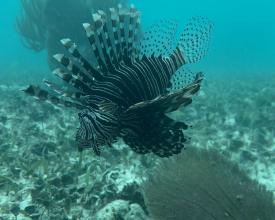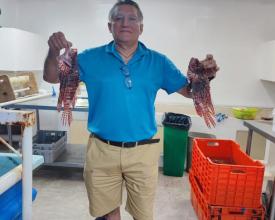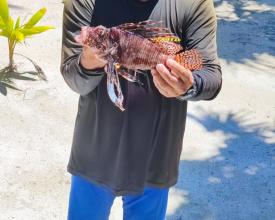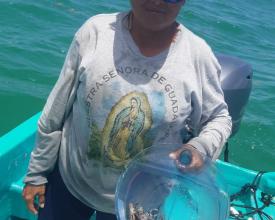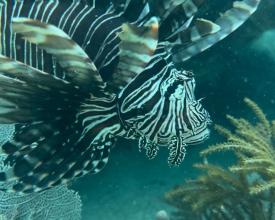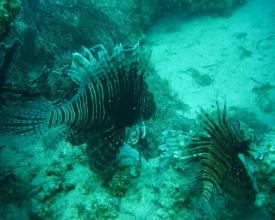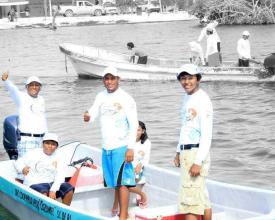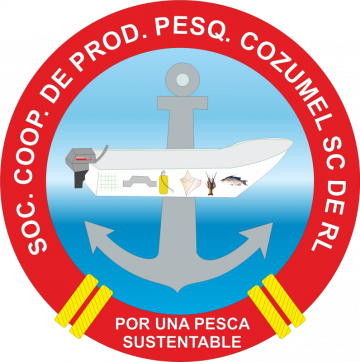
Actions to control an invasive marine species: lionfish
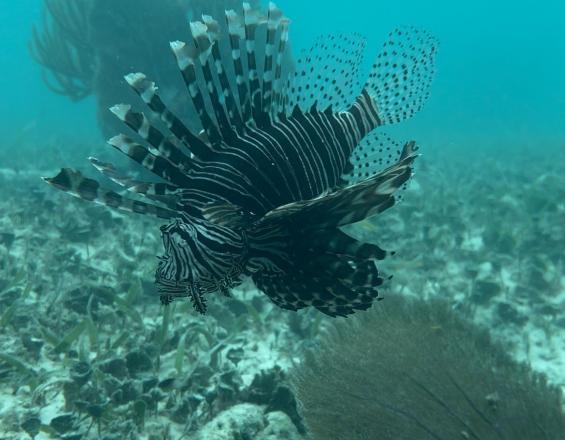
Invasive species are a threat to ecosystems. In the Mexican Caribbean, the invasion of lionfish has been a significant ecological, social and economic threat since 2010. Mainly because this species feeds on lobster larvae, which is our most valuable fishing resource in the area.
The fishing communities decided to act together with the government sector, academia, civil society organizations, private sector, etc., to seek solutions and control the invasion, in addition to implementing biological monitoring. We created joint actions to support the consumption of the species through gastronomic samples, recipes, fairs and fishing events, as well as to promote sport fishing aimed at catching lionfish.
The Sociedad Cooperativa de Producción Pesquera Cozumel has been a pioneer in promoting multiple initiatives to prevent the spread of the species and in transferring our knowledge to other fishing communities in Quintana Roo.
Contexte
Défis à relever
- Lack of economic resources to carry out control and monitoring actions at all levels (governments, communities and associations or organized groups).
- Not all regions or localities have a market study for lionfish, and the issue is not well publicized.
- In Mexico, control and monitoring is limited by the rules of underwater diving (a diver with Advanced open water diver certification can dive down to 30 meters/100 feet), since lionfish can be found at greater depths.
- Being a venomous species, one must learn to handle and handle with caution to avoid harm.
Emplacement
Traiter
Résumé du processus
The solution consists of two building blocks. The first refers to promoting the monitoring and control of an invasive species. This allows to evaluate first, what is the ecological, social and economic impact that the fishing communities may face; and second, how to carry out a standardized methodology for its control that allows to evaluate the populations among different communities.
The second building block discusses the lionfish sport fishing tournament strategy as a quick and effective alternative for the control of the invasive species, and in which more people can interact (nearby communities, fishermen from other cooperatives, among others). In addition, it allows the evaluation of the abundance of the species, biomass, size structure and catch per unit effort. Thus, both building blocks allow to evaluate and control the populations of an invasive species with different techniques or methodologies.
Blocs de construction
Lionfish monitoring in the Mexican Caribbean
Following a regional strategy for lionfish control helps to monitor, study and control an invasive species that can degrade or alter the marine biodiversity of the Mexican Caribbean. Since 2011, with the contribution of the National Commission of Natural Protected Areas (CONANP) and Community and Bioversity (COBI), a group of fishermen and fisherwomen from the SCPP Cozumel was formed and trained to carry out monitoring within the area, recording the abundance and size of lionfish in the water and taking biometric data when extracting them. Currently the group is not active because the species is now found at greater depths, unreachable for the monitoring divers, so only activities of extraction of the species are carried out, taking evidence through photographs.
This activity has been developed through a multisectoral effort between the fishing communities, civil society organizations, the government, and the private sector. The communities committed to this initiative and followed up on the monitoring to ensure its success. It should be noted that no monitoring activities were carried out within the Biosphere Reserve.
Facteurs favorables
- A multidisciplinary committee was formed and the best lionfish control, monitoring and study strategy was designed.
- The inclusion of women and men from the communities in the control and monitoring strategies was encouraged and they were trained in the development of these strategies.
- Funding sources were identified to support the implementation of the strategies.
- Information was provided and the knowledge generated was disseminated to develop the necessary regulations and policies for control at the national level.
Leçon apprise
- The creation of the "Regional Strategy for the Control of Lionfish" and the "National Action Plan for the Management and Control of Lionfish" has made it possible to align and focus the efforts of various stakeholders and reduce the effects of the invasive species in the region, through the exchange of experiences in communities that need support for its implementation, that have experimented with alternatives for the control of the species and effective communication between organizations.
- Promote actions linked to national policies, norms and regulations to support lionfish control and management actions, through links and collaboration with NGOs.
- By implementing efficient alternatives for the capture and commercialization of the invasive species, education and communication strategies have been implemented for the control, management and consumption of this species.
- Encouraging fishing communities to carry out biological monitoring and research has made it possible to promote the participation of communities and society in general to capture, monitor and consume the invasive species.
Sport fishing tournament to control lionfish invasion
Faced with the lionfish invasion, SCPP Cozumel, along with other local communities (Punta Allen and Punta Herrero), implemented a solution to control and monitor the lionfish. They organized to promote fishing tournaments as an initiative to: 1) cover larger extraction areas (especially of commercial interest) by joining efforts with other cooperatives, 2) use fishing effort to calculate lionfish abundances and the protection of priority sites, 3) encourage fishermen and fisherwomen to catch various sizes of interest of the species (juveniles and adults), 4) consume and experiment4) consume and experiment with lionfish fillet to create a recipe book with different dishes and promote its consumption, and 5) market the product locally.
Facteurs favorables
- To have the necessary structure, logistics and permits to carry out the fishing tournament in the region.
- Encourage fishermen and fisherwomen to participate by means of a competition (catching the largest fish, largest quantity, among others).
- Encourage equal participation; for example, women and men who cook are encouraged to prepare typical dishes, young people can be part of a jury, etc.
Leçon apprise
- Promoting actions to control lionfish helps conserve the marine ecosystem.
- Promoting actions among fishing communities fosters ties between cooperatives and contributes to the care of fishery resources.
- Creating a strategy within the fishing tournament with diverse stakeholders promotes the common good and inclusion. The fishing community in general participates (including women, youth and children). In addition, the tournament has promoted communication and information dissemination (taking advantage of community spaces to disseminate relevant information about the invasive species), promoting markets, gastronomic contests and the creation of a recipe book, generating biological information to evaluate the population of the species, and promoting the consumption of lionfish to contribute to its eradication.
Ressources
Impacts
The lionfish invasion in the region prompted major solutions and actions. The "National Action Plan for the Management and Control of Lionfish in Mexico" was created, which helped establish a Regional Committee to coordinate efforts across political and geographic boundaries. Research and monitoring efforts, modification of legislation, and development of new regulations and standards for lionfish control were promoted. An education and communication program for control and management was also implemented.
In Mexico, SCPP Cozumel is part of the regional committee, currently has a group of specialized monitors for lionfish control, we have carried out exchanges in fishing communities in Quintana Roo and with foreign communities in order to join efforts and organize tournaments to capture the species, promoting the diversification of activities and the inclusion of women, men and youth of the community. Also, thanks to marketing strategies and campaigns, we were able to position the lionfish in the local market as an exotic dish, creating handicrafts and generating a new source of economic income.
Bénéficiaires
The families of the 59 members who have been involved in the actions to eradicate lionfish and who are part of the SCPP Cozumel.
The families of fishermen and fisherwomen of the Mexican Caribbean, restaurateurs, formal and informal traders.
Objectifs de développement durable
Histoire
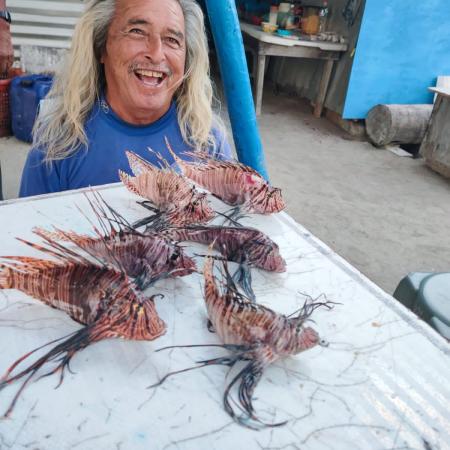
Fishing is the main economic activity for SCPP Cozumel, where the extraction and commercialization of Caribbean Spiny Lobster is the main source of income for the Cooperative.
Due to climate change and ocean currents, the lionfish had its first sightings in 2010, in areas where fishing activities are commonly carried out, affecting the ecosystem surrounding the lobsters and, in addition, preying on their young, which caused a large part of the lobster eggs not to reproduce and their population to decrease. All of this represented a serious risk to their main commercial activity, since the lobster population in the fishing zones decreased due to the predation of the invasive species. In response to this, the members of the SCCP Cozumel began to look for ways to extract and train themselves to control the species in a way that would not damage the ecosystem and that would allow them to take economic advantage of this resource.
It was not until 2012 that a group of fishermen began to extract the species and commercialize its fillet for the preparation of various dishes, thus implementing various strategies and activities to control the lionfish. For example, they participated in fishing tournaments to catch as many fish as possible within the fishing zones, they began to create culinary recipes to take advantage of the fish fillet, as well as fairs where they exhibited dishes and handicrafts made with lionfish spines and, most importantly, the SCPP Cozumel began to market this product to local restaurants, creating its own value chain. In all these activities, fisherwomen, fishermen and their families participated in order to contribute to the control of the species and to have a new source of income.
On the road to lionfish eradication, we have worked with CONANP, which provides resources directly to the fishermen and supports the cooperative through various programs such as PROCODES and PRODES to continue controlling the species. We have also worked with entities in the Yucatan Peninsula, Veracruz, and with the support of the International Accreditation Forum, we have had the opportunity to transmit all the knowledge of the value network and strategies to fishermen in Costa Rica, Colombia, Panama and Honduras, where they have also been affected by the invasion of this species.

